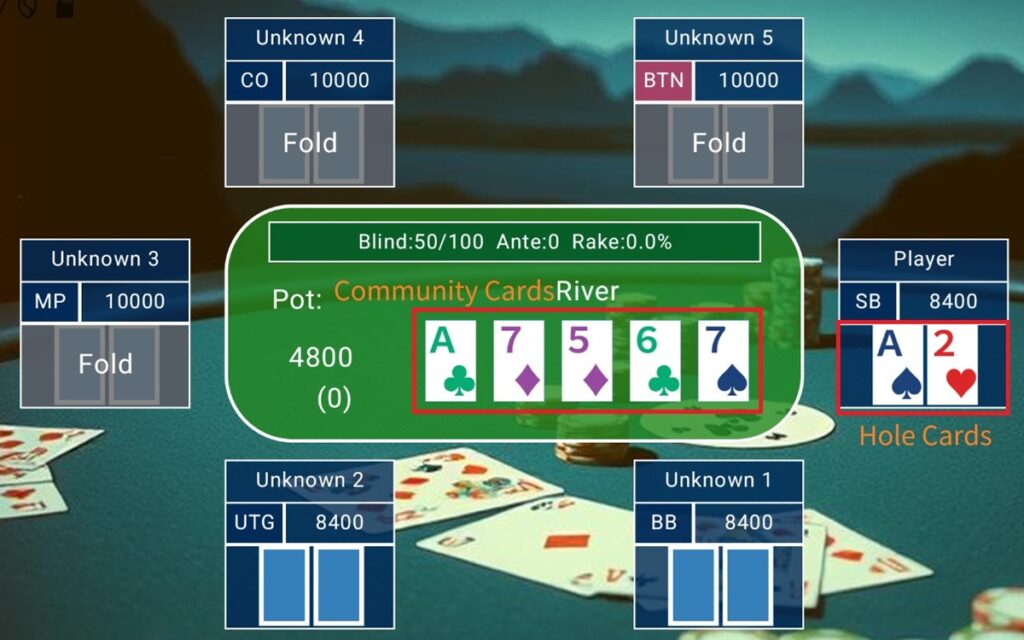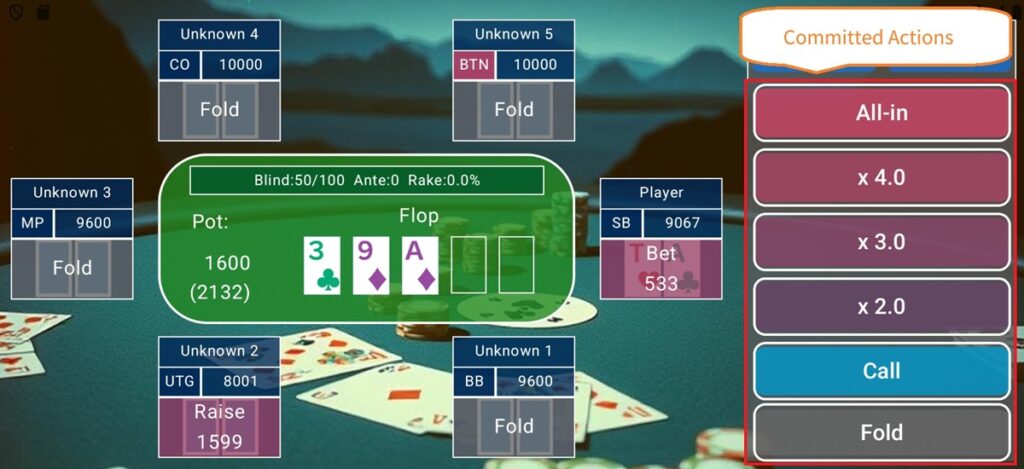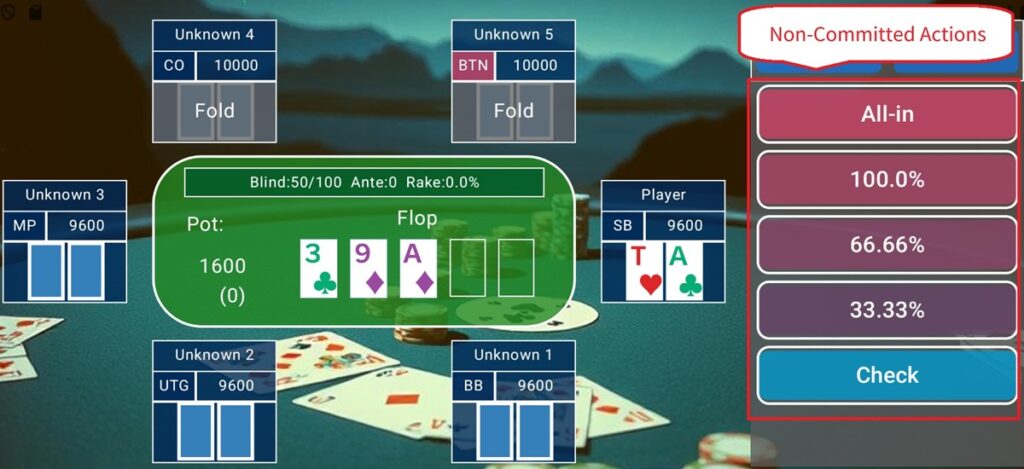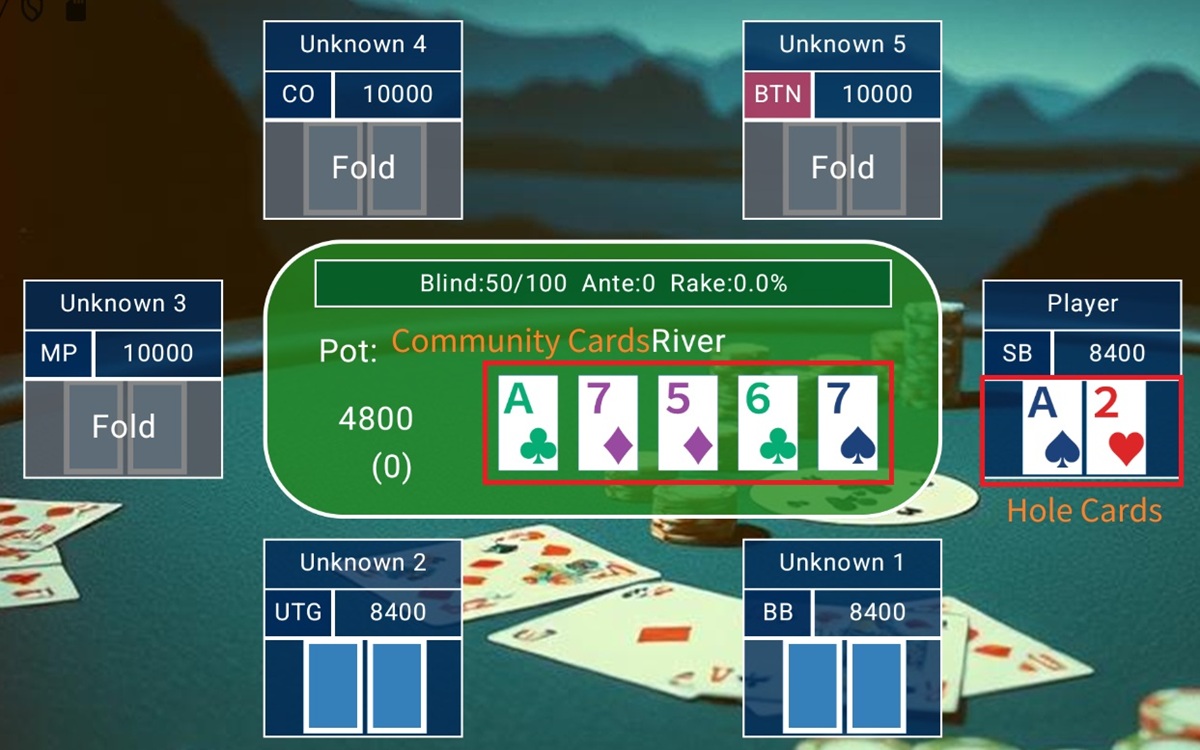In this game, Texas Hold’em is just one of the games you can play, but since it’s the most important game for understanding the basic rules, we’ll briefly explain it here. If you already know the rules, feel free to skip this section.
1. Basic Rules
The basic rules of Texas Hold’em are summarized simply as follows.
- The deck used consists of 52 cards, combining 13 ranks (A through K) and 4 suits (Spades, Hearts, Diamonds, Clubs).
- At the start of the game, each player is dealt 2 hole cards. Players can only see their own hole cards.
- On the table, there are five community cards that are revealed sequentially. Players use these five community cards along with their two hole cards to make the best possible five-card hand out of the total of seven cards.
- The player with the strongest hand wins and collects the total chips bet by the other players (the pot).
- Players look at their hole cards and the community cards and choose to raise their bets or fold.
- If they believe they have a strong hand, they bet more chips; if they believe their hand is weak, they bet less or fold, aiming to ultimately win more chips.

2. Dealer Button and Blinds
In Texas Hold’em, a marker called the dealer button (BTN) is used to determine the order of action. The dealer button moves clockwise after each hand.
The seat to the left of the dealer button is called the small blind (SB), and the seat to the left of the SB is called the big blind (BB). These two players are required to pay chips, with the SB paying half the blind amount and the BB paying one times the blind amount. For example, if the SB is 50 and the BB is 100, it is written as “50/100”.

The betting order is as follows:
- First round (Pre-flop): Action proceeds clockwise starting from UTG (the seat to the left of the BB), with the BB acting last.
- Subsequent rounds (Flop, Turn, River): Action proceeds clockwise starting from the SB, with the BTN acting last.
3. Game Procedure
One game consists of four betting rounds. The number of community cards revealed in each round varies.
- Pre-flop: Betting is done with hole cards only.
- Flop: Three community cards are revealed, and betting takes place.
- Turn: One more community card is revealed, and betting takes place.
- River: The final card is revealed, and final betting takes place.
If all players fold and only one player remains, the game ends at that point, and the remaining player is the winner.

If multiple players remain at the end of the River, the cards are revealed to determine the winner. This is called a Showdown. The winner takes all the chips in the pot. If the hands are equal, the chips are divided equally.
4. Actions Players Can Choose
In each round, players choose from the following actions. An action taken when someone has already put chips in is called a Committed Action.
- Call: Add chips to match the current highest bet and continue playing.
- Fold: Fold and end play. Chips already put in are not returned.
- Raise: Increase the bet amount and prompt other players to take action.
If a Raise occurs, each player starting from the player who raised decides their action. The round ends when no Raise is made by the player immediately to the right of the player who raised. The betting round ends and moves to the next round when all players who did not Fold have equal amounts of chips in the pot.

After the Flop, since there is no bet at the start of the round, you choose from the following actions. Actions taken when no chips have been placed are called Non-Committed Actions.
- Check: If no one has bet, pass the turn to the next player without placing chips.
- Bet: Place a new bet, forcing other players to either Fold, Call, or Raise.

Raise and Bet can generally specify any amount (though in practice, it must exceed the previous player’s raise amount). However, in this game, the amount of chips to commit is determined as follows:
- Raise: Specify a multiple of the current bet amount (e.g., double, triple).
- Bet: Specify a fixed percentage of the pot (e.g., 33%, 50%, 100%).
If you lack sufficient chips or wish to wager your entire remaining stack, you can choose All-in. Players who go All-in cannot participate in subsequent betting rounds, but if they win, they receive chips proportional to the amount they committed.
5. Poker Hand Rankings
Hands are ranked in descending order of strength as follows:
- Straight Flush: Five consecutive cards of the same suit
- Four of a Kind: Four cards of the same rank
- Full House: Three cards of one rank + two cards of another matching rank
- Flush: Five cards of the same suit (can be consecutive)
- Straight: Five consecutive cards of any suit
- Three of a Kind: Three cards of the same rank
- Two Pair: Two cards of one rank + two cards of another matching rank
- One Pair: Two cards of the same rank
- High Card: When no other hand is formed
Rank order is 2 < 3 < 4 < 5 < … < J < Q < K < A. Suit strength is generally irrelevant. Straight (including Straight Flush) order is
A2345 < 23456 < 34567 < … < 9TJQK < TJQKA.
Under standard rules, KA234, QKA23, and JQKA2 are not recognized as Straights.
If hands have the same type of hand, compare the rank of the cards included in that hand. If still tied, compare the rank of the remaining cards in order. If still tied, it’s a split pot (chop), and the pot is divided equally. The relative strength of each hand is determined as follows:
- Straight Flush: Rank of the straight
- Four of a Kind: Rank of four cards of the same rank > Rank of the rest card
- Full House: Rank of three cards of the same rank > Rank of another matching two cards
- Flush: Compare ranks in order of strength
- Straight: Rank of the straight
- Three of a Kind: Rank of three cards of the same rank > Rank of the rest card (compare all in order of strength)
- Two Pair: Rank of the two pairs in order of strength > Rank of the single card
- One Pair: Rank of the pair > Rank of the rest card (compare all in order of strength)
- High Card: Compare ranks in order of strength
6. Chip Distribution
If there is one winner, that player wins the entire pot. If multiple players tie, the pot is split evenly. If a fraction remains, it is distributed starting from the player to the dealer’s left.
When an all-in occurs, create side pots based on the difference in bets and distribute them as follows:
- Create side pots based on the amount each player contributed. For example, if Player 1 contributes 50 (all-in), Player 2 contributes 100 (all-in), and Players 3 and 4 contribute 200 chips:
- Side Pot 1: 50 × 4 = 200 (winner determined among Players 1, 2, 3, 4)
- Side Pot 2: 50 × 3 = 150 (winner determined among Players 2, 3, 4)
- Side Pot 3: 100 × 2 = 200 (winner determined among Players 3, 4)
- The winner is determined from the pot containing the player who bet the smallest amount, and that player wins the chips in that range.
- The remaining pots are similarly determined and distributed in sequence.
The rules may seem complex, but since everything is automatically calculated in this game, it’s sufficient to simply know these rules exist. After the game ends, move the dealer button one position to the left and proceed to the next hand. These are the basic rules of Texas Hold’em.
